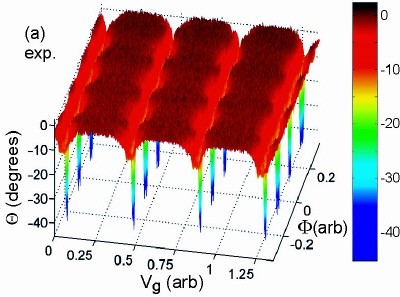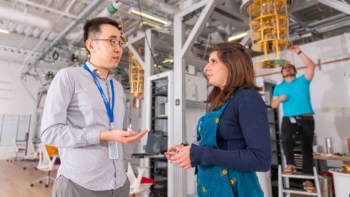Two teams of physicists have measured the capacitance of a Josephson junction for the first time. The methods developed by the two teams could be used to measure the state of quantum bits in a quantum computer without disturbing the state.

A Josephson junction consists of two superconducting layers separated by a thin insulating layer. Brian Josephson of Cambridge University won the Nobel prize in 1973 for predicting, while he was still a PhD student, that the Cooper pairs in the superconducting layers would be able to tunnel through the insulating layer without losing their superconducting properties. Josephson junctions are widely used in many electronic devices, including logic circuits, memory cells and amplifiers. Superconducting quantum interference devices (SQUIDs), also rely on the junctions to measure extremely small magnetic fields.
In the classical regime, the junction behaves like an inductance. In the 1980s, however, theorists predicted that a Josephson junction would behave like a capacitor if it was small enough. Now, Per Delsing and colleagues at Chalmers University of Technology in Sweden, and independently, Pertti Hakonen and co-workers at Helsinki University of Technology and the Landau Institute of Theoretical Physics in Moscow have observed this effect in experiments for the first time.
The Sweden team measured the effect in a Cooper-pair transistor, a device that contains two Josephson junctions in series (Phys. Rev. Lett. 95 206806). The Helsinki-Moscow group saw the effect in a Cooper-pair box, which contains one junction (Phys. Rev. Lett. 95 206807).
Delsing and colleagues at Chalmers University began by embedding their Cooper-pair transistor in a resonant circuit. Next, they cooled the device down to millikelvin temperatures and measured how the phase of a radio-frequency signal changed when it was reflected from the circuit. Based on these measurements, the team was able to show that the device behaved like a quantum capacitor. Hakonen and co-workers in Helsinki and Moscow group employed a similar technique. Both teams found that the devices behaved as predicted by theory.
The effect could be used to read out quantum bits (qubits) in a reliable way because the quantum capacitance of the excited state of the qubit has the opposite sign to the ground state. These states could be used as the “1s” and “0s” in a quantum computer. Indeed Hakonen and colleagues have already used this approach to read the value of a qubit without changing its value — which is almost always a problem when measuring the quantum state of any system.
“In the future, the Josephson capacitance could be used for operations in a large-scale quantum computer,” says Mika Sillanpaa of Helsinki University. “The Josephson inductance and Josephson capacitance together would also allow us to build new types of quantum ‘band engineered’ electronic devices, such as low-noise parametric amplifiers.”




